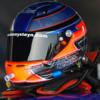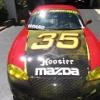I have a 99 and a 1.6. I'm running the 1.6 at NASA races that I plan to attend this year. If I just had the 99 I would not be racing with NASA. I actually think the new rules were good for NASA (car counts)and if they would just change the restrictor size up to a 39mm I think it would be a good compromise and allow the 99's to at least be competitive. Just my personal opionion, now back to the debate 
Like Gale, I have both a 99 and a 1.6. I have raced 2 NASA events this year one in each car. The first race in the 99 with no plate, it was not required. We did dyno my 99 after the event and it dropped about 5 Hp. The second race was at a track that favored the 1.6 before the rule change so I ran the 1.6.
I will not be running my 99 at any of the other NASA events because it would be my second best car.
I run which ever car gives me the advantage at SCCA events because I can.
One of the problems I have with the NASA rules is the drop in weight of the 99. I can't make weight in the 99, I'm 40 lbs over with no balast. So small restrictor, heavier car, no race when I have the option of faster, reasonably prepped 1.6.
As to what Alex B. has experienced, I should not be able to race with him or his peers at the front end of the field in either car. I am new/learning midpack racer. It would not be parity if me or my midpack peers were suddenly racing for the podium against, Alex, Blake, Highchair, Burgoon.....
Parity would be Alex B. driving a 1.6 against Blake in his 99 at neutral track, (MSR Houston). The cars are very close in parity under the SCCA rules when in the hands of talented drivers at neutral tracks. From what I have observed one car or the other is the overdog depending on the track under the SCCA rules.
If NASA raced at Texas Motor Speedway we would probably see how handicapped the 99 is with the new rules. Under the SCCA rules the 99 is a clear favorite at TMS. (In my opinion)A medium prepped 1.6 should be able to easily handle the 99 with the NASA rules at TMS. The track is simple enough to alow the midpack drivers to compete with the front end just based on the cars overal speed. That is not the definition of parity. NASA doesn't race there so its a moot point but it is a problem.
From my observations the track dictates which car is the favorite more so than the RP and weight.
IMHO NASA should reduce the 99' RP to 39 mm and set weight to 2450.
Does it really matter what a midpacker thinks?
With NASA yes, with SCCA not so much.




 Sign In
Sign In Create Account
Create Account














 Back to top
Back to top Report
Report


















